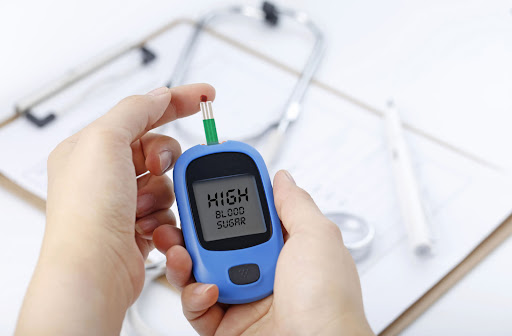Did you know that if you have diabetes, it can affect your eyes? Diabetic retinopathy is an eye condition and a complication of diabetes that affects approximately 30% of adults over age 40.
This eye condition is caused by damage to the blood vessels in the retina (the light-sensitive tissue at the back of the eye) and can lead to blindness. Diabetes also increases your risk of developing other eye conditions, such as glaucoma and cataracts.
If you have diabetes, it’s essential to have regular diabetic eye exams. These can help your optometrist check for signs of diabetic retinopathy, monitor any symptoms, and provide treatment options to preserve your eyesight.
So is diabetic retinopathy reversible? While diabetic retinopathy can’t be reversed, if caught early, additional vision loss and eye damage can be prevented. Keep reading to learn more about diabetic retinopathy, its stages, and available treatment options.
How Does Diabetes Cause Diabetic Retinopathy
Diabetes affects your body’s ability to use glucose (sugar), an essential source of energy for your cells. When your body can’t process glucose, it can lead to excess levels of sugar in your blood. When your blood sugar levels remain too high for too long, you can develop serious health conditions.
Your eyes are especially sensitive to high blood sugar levels. The tiny blood vessels that supply the retina (the light-sensitive tissue at the back of the eye) can become blocked and damaged, leading to diabetic retinopathy. Blocked and damaged blood vessels can swell and leak, stopping the blood supply to your retina. In severe cases, your eyes may grow new, abnormal blood vessels.
All of these factors can cause irreversible vision loss.
Risk Factors for Developing Diabetic Retinopathy
Having diabetes is the biggest risk factor for developing diabetic retinopathy. Your risk can also increase if you:
- Have had diabetes for a long time
- Have high blood sugar or poor control over sugar levels
- Have high blood pressure
- Have high cholesterol
- Smoke
- Have gestational diabetes (diabetes while pregnant)
Symptoms of Diabetic Retinopathy
You’ll likely not notice early symptoms of diabetic retinopathy. We will discuss the different stages of diabetic retinopathy in the next section, but here are some symptoms that can develop as this condition progresses:
- Loss of central vision, which you might notice when you read or drive
- Blurred vision
- Fluctuating vision
- Difficulty seeing colors
- Floaters, which are spots or dark strings in your vision
- Holes or dark areas in your vision
Stages of Diabetic Retinopathy
There are 2 main stages of diabetic retinopathy: nonproliferative and proliferative. Nonproliferative is further divided into mild, moderate, and severe retinopathy.
Nonproliferative Diabetic Retinopathy (NPDR) or Early Stage
This early stage presents with nonexistent or mild symptoms. It occurs when the retinal blood vessels start to weaken and bulge. When this happens, they can sometimes also leak fluid and blood.
This stage can go from mild to severe if more blood vessels become blocked. Sometimes, fluid can leak into the macula (center part of the retina) and cause swelling (edema—buildup of fluid). Macular edema occurs in half of those with diabetic retinopathy and can lead to vision loss.
Proliferative Diabetic Retinopathy (PDR) or Advanced Stage
In this advanced stage, damaged blood vessels are blocked and deprive the retina of oxygen. In response, your eyes grow new, abnormal blood vessels, which are fragile and prone to breakage. When these abnormal blood vessels break, they can leak fluid and blood into the vitreous, clouding vision.
PDR can also cause further complications by causing scar tissue and neovascular glaucoma. Scar tissue can lead to retinal detachment—when the retina is pulled from the back of the eye—and glaucoma damages the optic nerve.

Treatment for Diabetic Retinopathy
There is no cure for diabetic retinopathy, but symptoms and complications can be treated to prevent vision loss. Treatment can slow down or reverse diabetic retinopathy.
Anti-VEGF Injections
In certain eye conditions, the body produces a protein—vascular endothelial growth factor (VEGF). Too much of this protein can cause abnormal growth of blood vessels and blood vessels to leak. Anti-VEGF can block this protein, reverse abnormal blood vessel growth, and prevent fluid buildup.
- Laser therapy: This treatment, also called laser photocoagulation, can stop or slow leakage from blood vessels and reduce swelling in the retina.
- Vitrectomy: This procedure removes the vitreous fluid and replaces it with a clear fluid.
- Retinal reattachment: This procedure reattaches the retina to the back of the eye.
- Corticosteroids: Medications used to reduce swelling.
How to Protect Your Vision & Prevent Diabetic Retinopathy
Although diabetic retinopathy is not curable, there are ways to prevent or reduce your risk of developing diabetic retinopathy:
- Manage your diabetes by keeping blood sugar levels in your target range
- Control your blood pressure and cholesterol with medication
- Quit smoking
- Exercise regularly
- Get a dilated eye exam yearly or more often if recommended by your eye doctor
Diabetic Eye Exams Preserve Vision
Diabetic retinopathy is a vision-threatening eye disease caused by diabetes. For effective and early treatment of diabetic retinopathy, book an appointment with Pinnacle Eyecare so we can help you prevent damage and preserve your vision for longer.






